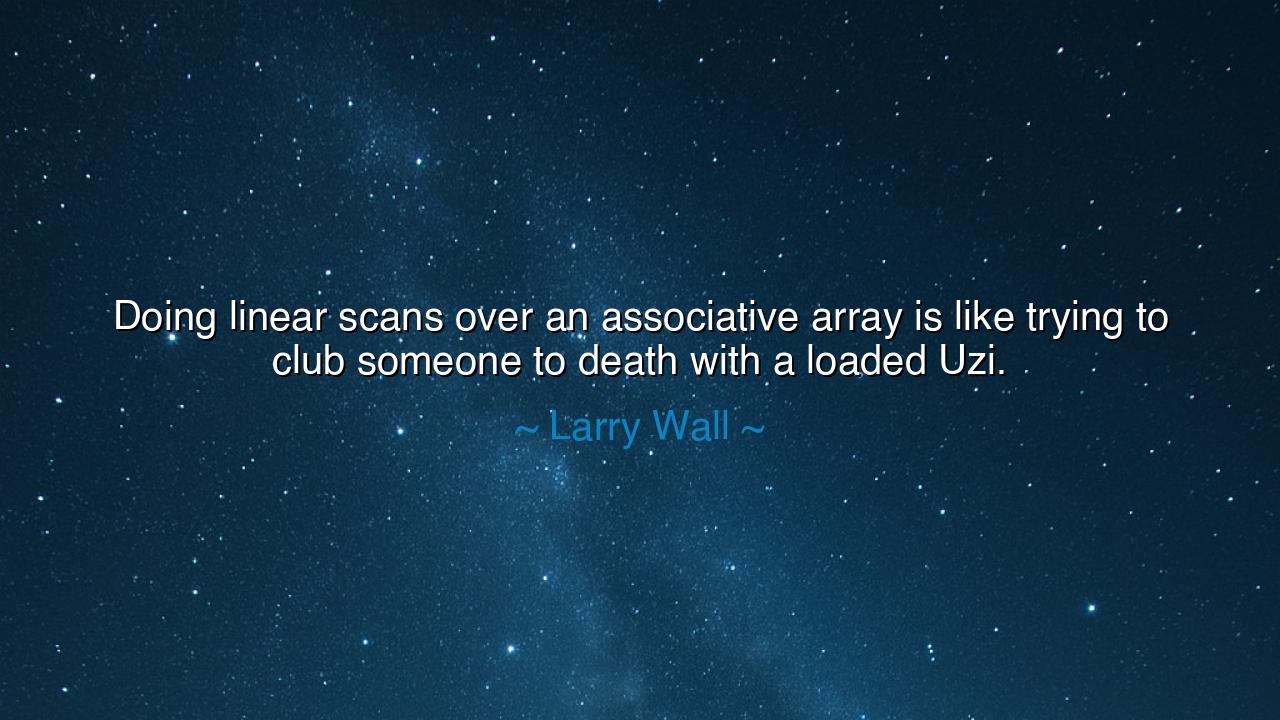
Doing linear scans over an associative array is like trying to
Doing linear scans over an associative array is like trying to club someone to death with a loaded Uzi.






“Doing linear scans over an associative array is like trying to club someone to death with a loaded Uzi.” Thus spoke Larry Wall, the creator of the Perl language—philosopher among programmers, whose wit conceals the wisdom of an elder craftsman. In these sharp and vivid words, Wall does not merely jest about code; he unveils a timeless principle of human endeavor: that to possess power without understanding is folly, and to misuse one’s tools is to betray both skill and purpose. The Uzi, swift and deadly, symbolizes potential—efficiency, precision, mastery. To club with it, instead of firing, is to waste its gift, to trade grace for chaos. And so in this saying, we glimpse not only the humor of a programmer but the cry of a teacher urging mortals to use their tools wisely.
In the realm of programming, the “associative array” is a powerful creation—a map of knowledge, a device meant for lightning-fast access to what one seeks. To perform a linear scan upon it, searching element by element, is to ignore the very magic it was built to offer. It is as if one, having been granted wings, chose instead to crawl. Wall’s metaphor, both humorous and biting, reminds us that understanding is the soul of mastery. Tools, no matter how wondrous, serve only as well as the mind that wields them. To misunderstand their nature is not harmless—it turns potential into burden, and power into confusion.
The ancients knew this truth long before the age of silicon and syntax. Consider Daedalus, master craftsman of myth, who fashioned wings to escape imprisonment. His son Icarus, unmindful of the principles that governed his gift, flew too high and fell to ruin. The wings themselves were flawless—the failure lay in their misuse. So too with technology and knowledge: the peril is not in the tool, but in the ignorance of its wielder. Larry Wall’s jest, cast in the language of computers, is thus a reflection of the same ancient law—that the wise must learn the essence of the instruments they command, lest their strength turn upon them.
In Wall’s metaphor, there also lies a deeper teaching on efficiency and elegance. For in every craft—be it code, music, warfare, or philosophy—the mark of mastery is not in brute force but in precision. The wise do not strike blindly when a single well-aimed act will suffice. To club with a loaded Uzi is to mistake activity for achievement, movement for meaning. The novice may delight in motion, in the noise of labor, but the sage seeks effectiveness, the quiet perfection of effort aligned with purpose. This, too, is the heart of all great art and science: to know what not to do.
Let us recall a tale from the age of invention. When Thomas Edison labored to create the electric light, he tested thousands of filaments—some mock him for this, saying he “failed” thousands of times. Yet he was not swinging the weapon blindly; each strike was measured, informed, building toward revelation. He understood his tools, and thus his persistence bore fruit. Contrast this with those who, armed with modern knowledge, wield it carelessly—writing code without thought, using technology without principle, flooding the world with noise instead of light. To them, Wall’s words are a mirror: you hold power but not wisdom; you swing the Uzi instead of firing it.
In every discipline, from the scholar’s desk to the artisan’s forge, this truth applies. To work without understanding is to fight against one’s own creation. The craftsman must study the nature of his materials, the musician must learn the breath of his instrument, the leader must know the hearts of his people. So too must the programmer learn the rhythm of his machine. The tool is sacred only when used as intended; misuse profanes both the tool and its maker.
Thus, O listener and seeker of mastery, take heed of Larry Wall’s wisdom disguised in jest. Do not mistake effort for excellence. Do not mistake possession for understanding. When you wield a powerful tool—be it knowledge, technology, or authority—learn first its purpose. Study it until its logic becomes your own. For in the hands of the wise, even the simplest tool becomes divine; but in the hands of the careless, even the mightiest weapon becomes absurd.
And so, remember this: mastery is not power, but harmony. To use the right means for the right end—that is the mark of greatness. Whether in code or in life, seek not to “club” your way through tasks when precision and understanding could achieve the same in elegance. For to act with wisdom is to fire the weapon of the mind true and clean—to strike once, and be done.






AAdministratorAdministrator
Welcome, honored guests. Please leave a comment, we will respond soon